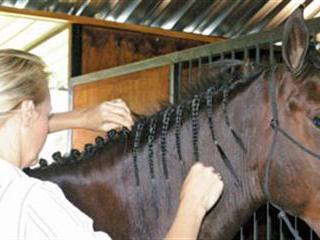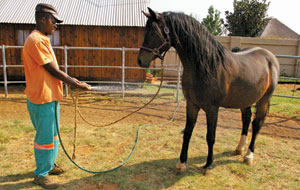
Washing your four-legged friend is a very important part of owning a horse. It can be a great bonding experience. On the other hand, if you don’t do things properly, you could end up having a water fight with your horse that leaves you sopping wet, while your horse remains dry and dirty.
The area used for washing should be large, open and free of obstacles. A 15m round pen is ideal. You’ll need to wash your horse on a ‘non-slip’ surface, such as sand, grass or good old-fashioned soil. If your horse is shod, do not wash him on concrete. Imagine running your nails down a blackboard – that’s what shod hooves feel like on wet concrete.
Obviously, a warm day is best for bathing. With cool water on a hot body pleasant and rewarding, this will ensure the experience is positive.
You’ll need the following:
- A long hosepipe, with an attachment that adjusts water pressure.
- A horse shampoo for the body and a baby shampoo for the head. You’ll also need a horse conditioner. Animal skins have a specific pH, so use products developed for them as far as possible.
- A rubber grooming mitt and a water brush for the hooves.
- A well-fitted halter and a soft cotton lead rope.

First introduce the horse to water by showing it a gentle stream of water.
Stay calm
Once you’ve put on the head collar and settled your horse, show it the water. Stay calm. Do not frighten your horse. The idea is to get it to trust you. Hold the lead rope in one hand and the hose in the other. Stand slightly to the side of your horse, with the hose behind you. This way your horse won’t get tangled in the hose if it jumps forward. First hold the hose away from your horse, so that the water doesn’t touch it. When you’re sure it is relaxed and comfortable, start to move the hose closer.
Never shout. With patience your horse will learn to stand still while you wash. Start washing the hooves first. Let the water flow slowly. Then gently go up the leg. If your horse shows signs of nervousness, go back down. Make reassuring noises. This is a faith-building exercise. Your horse needs to know that it can trust you. Every time you put water on a new area and it responds positively – stands still and accepts the water – go back down to the hoof. This will then be a safety zone.
Be considerate
Now wet the shoulder. Moving away from you is a natural response. Gently apply pressure to the halter and move the horse into place again. Then reduce the water pressure and wet the face. No one likes water in their ears and eyes, so be considerate. If your horse moves away from you again, gently pull it. Repeat until the whole body is wet.
Now you’re ready to shampoo. Use the mitt to give a good gentle scrub/massage over the entire body. When your horse is sudded up, you can start to rinse. Begin at the rump and move to the head. Once all the soap is washed off, increase the water pressure slightly. Repeat the above steps with the conditioner. Never leave a sweaty horse without at least grooming the dried salt out of its coat. Even a quick rinse with water is better than being turned out covered in dry sweat.
Contact Kim Dyson on 082 888 6511 or at [email protected]. Please state ‘Horse therapy’ in the subject line of your email.








